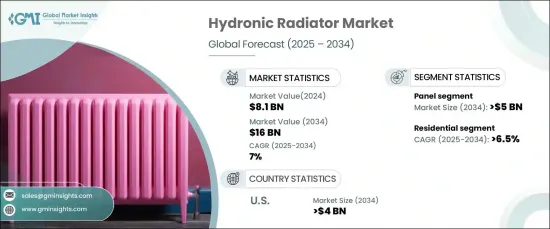PUBLISHER: Global Market Insights Inc. | PRODUCT CODE: 1664848

PUBLISHER: Global Market Insights Inc. | PRODUCT CODE: 1664848
Hydronic Radiator Market Opportunity, Growth Drivers, Industry Trend Analysis, and Forecast 2025 - 2034
The Global Hydronic Radiator Market was valued at USD 8.1 billion in 2024 and is projected to expand at a compound annual growth rate (CAGR) of 7% from 2025 to 2034. The increasing focus on environmental sustainability and heightened awareness of energy conservation are key drivers of this market growth. The adoption of advanced technologies, combined with the precision and comfort offered by these systems, has further propelled their use in both residential and commercial settings.

Hydronic radiators function as part of a heating system where water is heated in a boiler and circulated through pipes to provide warmth. Growing demand for energy-efficient solutions and modern heating technologies is reshaping the market landscape. Supportive government policies, including incentives and subsidies for energy-efficient heating systems, are accelerating the adoption of these technologies and encouraging sustainable practices in property heating.
| Market Scope | |
|---|---|
| Start Year | 2024 |
| Forecast Year | 2025-2034 |
| Start Value | $8.1 Billion |
| Forecast Value | $16 Billion |
| CAGR | 7% |
The panel radiator segment is expected to surpass USD 5 billion by 2034, driven by the increasing need for efficient and space-saving heating solutions. These radiators are gaining popularity for their sleek designs and effective heat distribution, which enhance both comfort and aesthetics. Rising urbanization and construction activities, coupled with the demand for better air quality and reduced noise levels, are further boosting the adoption of panel radiators. Additionally, growing regulatory pressure to comply with environmental standards supports the widespread use of these systems.
The residential segment is forecasted to grow at a CAGR of over 6.5% by 2034, fueled by rising awareness about energy efficiency and environmental impact among homeowners. Advanced technologies, such as smart home integration, are playing a significant role in this growth. The ability to improve comfort and provide precise control over indoor temperatures makes hydronic radiators a preferred choice for modern households. The ongoing trend of home renovations and the integration of these systems with renewable energy sources like solar panels are creating new opportunities in the market.
The US hydronic radiator market is projected to exceed USD 4 billion by 2034, owing to the rising demand for visually appealing and space-efficient heating solutions. Continuous advancements in hydronic heating technologies, including the development of lightweight and thermally efficient materials, are enhancing product appeal. Furthermore, the integration of these systems with smart home technologies is driving widespread adoption, making hydronic radiators an integral part of modern heating solutions.
Table of Contents
Chapter 1 Methodology & Scope
- 1.1 Market scope & definitions
- 1.2 Market estimates & forecast parameters
- 1.3 Forecast calculation
- 1.4 Data sources
- 1.4.1 Primary
- 1.4.2 Secondary
- 1.4.2.1 Paid
- 1.4.2.2 Public
Chapter 2 Executive Summary
- 2.1 Industry synopsis, 2021 - 2034
Chapter 3 Industry Insights
- 3.1 Industry ecosystem analysis
- 3.2 Regulatory landscape
- 3.3 Industry impact forces
- 3.3.1 Growth drivers
- 3.3.2 Industry pitfalls & challenges
- 3.4 Growth potential analysis
- 3.5 Porter's analysis
- 3.5.1 Bargaining power of suppliers
- 3.5.2 Bargaining power of buyers
- 3.5.3 Threat of new entrants
- 3.5.4 Threat of substitutes
- 3.6 PESTEL analysis
Chapter 4 Competitive Landscape, 2024
- 4.1 Introduction
- 4.2 Strategic outlook
- 4.3 Innovation & sustainability landscape
Chapter 5 Market Size and Forecast, By Type, 2021 – 2034 (USD Million)
- 5.1 Key trends
- 5.2 Panel
- 5.3 Baseboard
- 5.4 Convector
- 5.5 Fan coil
- 5.6 Others
Chapter 6 Market Size and Forecast, By End Use, 2021 – 2034 (USD Million)
- 6.1 Key trends
- 6.2 Residential
- 6.3 Commercial
- 6.4 Industrial
Chapter 7 Market Size and Forecast, By Region, 2021 – 2034 (USD Million)
- 7.1 Key trends
- 7.2 North America
- 7.2.1 U.S.
- 7.2.2 Canada
- 7.3 Europe
- 7.3.1 UK
- 7.3.2 Germany
- 7.3.3 France
- 7.3.4 Italy
- 7.3.5 Spain
- 7.3.6 Finland
- 7.3.7 Denmark
- 7.3.8 Austria
- 7.3.9 Belgium
- 7.4 Asia Pacific
- 7.4.1 China
- 7.4.2 Japan
- 7.4.3 India
- 7.4.4 South Korea
- 7.4.5 Australia
- 7.5 Middle East & Africa
- 7.5.1 Saudi Arabia
- 7.5.2 UAE
- 7.5.3 Turkey
- 7.5.4 South Africa
- 7.6 Latin America
- 7.6.1 Brazil
- 7.6.2 Argentina
- 7.6.3 Mexico
Chapter 8 Company Profiles
- 8.1 Advanced Hydronics
- 8.2 Bosch Thermotechnology
- 8.3 Cambro
- 8.4 Chappée
- 8.5 Embassy Industries
- 8.6 Fondital
- 8.7 Governale Company
- 8.8 Haverland
- 8.9 Henrad
- 8.10 Hudson Reed
- 8.11 Hydrotherm Hydronic Heating
- 8.12 Jaga
- 8.13 Kermi
- 8.14 MYSON
- 8.15 Purmo Group
- 8.16 Runtal North America
- 8.17 Seltron
- 8.18 Stelrad
- 8.19 U.S. Boiler Company
- 8.20 Wiseliving




